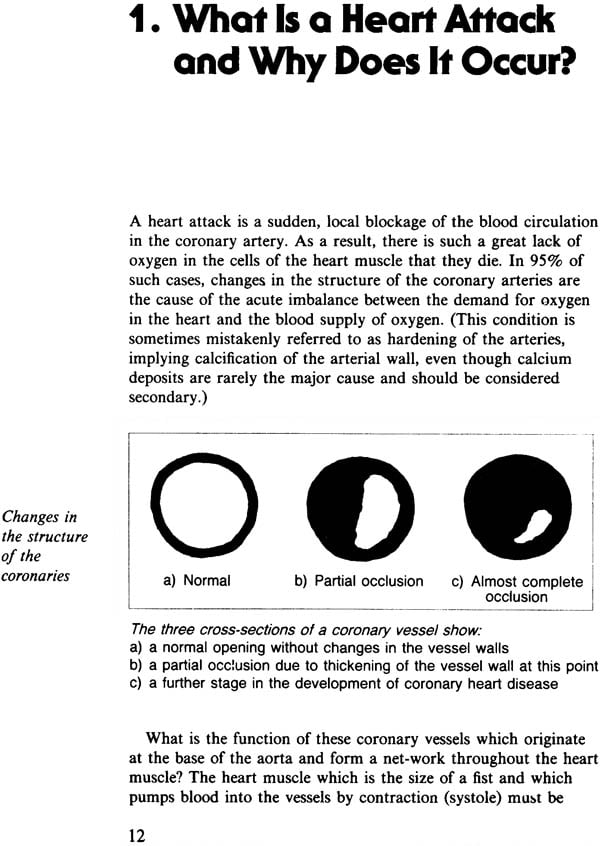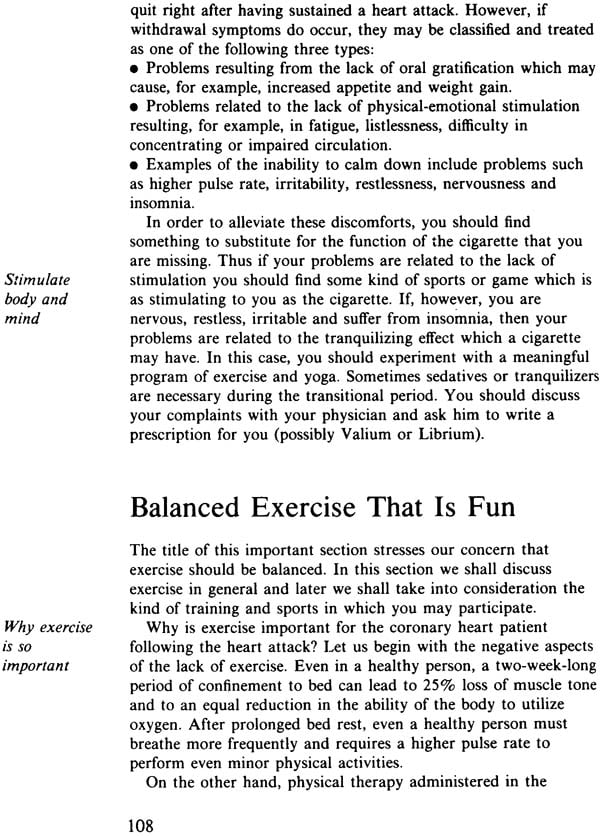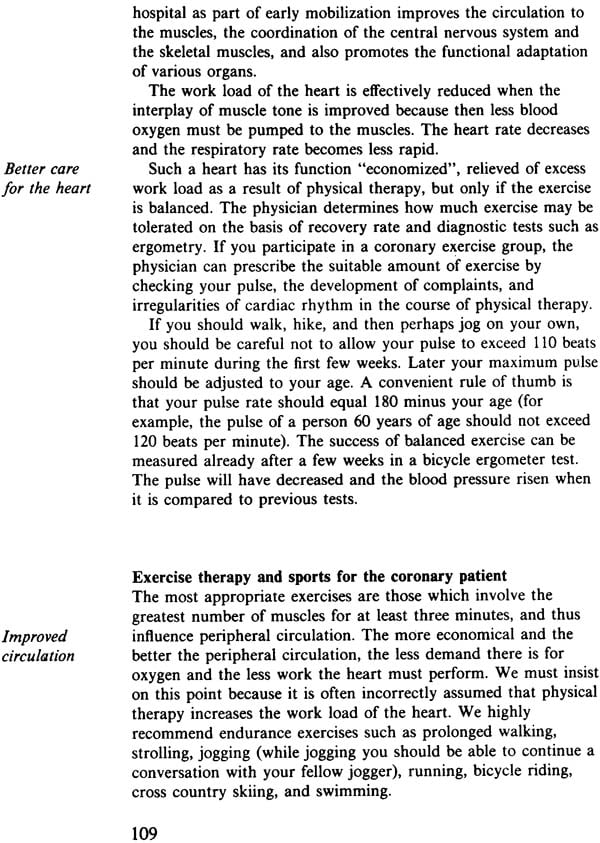
Speaking of Heart Attacks (An Invaluable Guide to Detect and Prevent Heart Diseases)
Book Specification
| Item Code: | NAM327 |
| Author: | Carola Halhuber and Max J. Halhuber |
| Publisher: | Sterling Publishers Pvt. Ltd. |
| Language: | English |
| Edition: | 2010 |
| ISBN: | 9788120702615 |
| Pages: | 128 (21 B/W Illustrations) |
| Cover: | Paperback |
| Other Details | 8.5 inch x 5.5 inch |
| Weight | 170 gm |
Book Description
This book informs persons who risk or have sustained a heart attack as a result of coronary artery disease how it is possible to help them and how they may help themselves.
In this new volume of the Medical Adviser Series two experienced cardiologists, who have been involved for many years in research of the causes and consequences of this disease, give a comprehensive description of heart attack and its effects. They answer questions which are brought up daily by those who are affected by heart attack and coronary disease in general.
Yet another purpose of this book is to make patients specialists of their particular chronic disease with the cooperation of their physician. The book is meant to become a reliable adviser on the way to a 'second life', one which may be consulted at any time by patients and their families.
Carola Halhuber, M.D., born in 1936 in Baden-Baden, received her medical education at the Universities of Freiburg, Vienna, Berlin and Munster.
She was head of the Clinic of Cardio-vascular Disease in Baden-Baden and of the private Hospital "Lauterbacher Muehle" for coronary patients at Osterseen in Bavaria from 1964 to 1974. Since 1974 she has worked in the intensive care unit of the County Hospital in Munich-Pasing.
She is a trustee member of the German society concerned with the dangers of addiction, speaker for a group of specialists on smoking, and head of an outpatient coronary group.
Max J. Halhuber, MD., Professor of Medicine, born in 1916 in Innsbruck, studied medicine in Innsbruck, Vienna, Freiburg, Paris, and Boston.
He was chief resident of the University Hospital in Innsbruck until 1967. Since 1968 he has been the medical director of the Hoehenried Hospital for Cardio- vascular Disease.
He is professor of medicine at the University of Innsbruck and the Technical University of Munich.
In Germany the patient with a heart attack is referred to a special center for cardiac rehabilitation after his hospitalization for acute care. One such center in Bavaria is run by Dr. Max Halhuber who shares his experience and knowledge with us in this book, written for the patient and his family.
In the United States we have superb facilities for care during the acute phase of the heart attack. However, we neglect the important rehabilitation and reconditioning process and put up with the high cost, both socially and economically, of prolonged disability and premature retirement.
A statement was made to me by one of the officials of a Blue Shield plan when challenged over the Blue Plan's policy of not paying for a rehabilitation program. He stated, "The Blue Plans are in business to insure against acute illness. We are not in the business of prevention nor in the business of rehabilitation, much as we applaud their aims." If the individual is fortunate enough to have major medical coverage, rehabilitation programs may be covered.
It is unfortunate in these days of pressures for cost containment in medical care that we neglect rehabilitation and secondary prevention. As a matter of fact, even primary prevention programs suffer.
It has been estimated that in the United States coronary disease strikes 21/2 million individuals, and that one in five men can expect to have a heart attack before age 60. While institutional rehabilitation will probably never come to this country, and, indeed, is probably not needed, we must find a higher priority for prevention and rehabilitation programs.
Dr. Halhuber has a lot to tell us about coronary artery disease and heart attacks, and this book offers a large amount of medical information in terms understandable by patients and their family.
| Preface | 8 | |
| Why This Book Is Important to Us | 9 | |
| 1 | What Is a Heart Attack and Why Does It Occur? | 12 |
| 2 | Risk Factors | 18 |
| Life-Style and Habits Which May Lead to a Heart Attack | 18 | |
| Risk Factor: Elevated Blood Fat Levels | 18 | |
| Risk Factor: Low Levels of HDL-High Levels of LDL-Cholesterol | 20 | |
| Risk Factor: Diabetes | 22 | |
| Evaluation of blood glucose and urinary sugar | 22 | |
| Risk Factor: Elevated Uric Acid in the Blood (Hyperuricemia) | 23 | |
| Risk Factor: Overweight | 23 | |
| Risk Factor: High Blood Pressure (Hypertension) | 24 | |
| Risk Factor: Cigarette Smoking | 25 | |
| Risk Factor: Lack of Exercise | 26 | |
| Risk Factor: Hereditary Factors | 26 | |
| Risk Factor: Inflammations and Infections | 26 | |
| Risk Factor: Contraceptive Pills | 27 | |
| Risk Factor: Psycho-Social Stress and Risk Personality | 27 | |
| What Are Your Personal Risk Factors? | 30 | |
| Can Heart Attacks and Re-Infarctions Be Prevented? | 31 | |
| 3 | Cardio-Vascular Diagnostic Workshop | 34 |
| What Complaints and Symptoms May Indicate | 34 | |
| The Physical Examination | 41 | |
| EKG at Rest and Work (Bicycle Ergometry) | 42 | |
| Fluoroscopy and X-Rays | 43 | |
| Special Examinations | 43 | |
| Coronary angiography | 43 | |
| Swan Gans catheter | 47 | |
| Heart scintiscan | 48 | |
| Echo-cardiography | 49 | |
| Discussion of the Results of an Examination | 50 | |
| 4 | The Impending Heart Attack and the Acute State | 52 |
| The First Signs of a Heart Attack | 52 | |
| Symptoms of the Acute Stage | 54 | |
| The Dangers of the First Hours | 56 | |
| What Can Relatives Do If a Heart Attack Is Suspected? | 57 | |
| What Should the Patient and Relatives NOT Do? | 59 | |
| Immediate Measures for Resuscitation | 59 | |
| Heart massage and artificial respiration (mouth-to-mouth or mouth-to-nose) | 60 | |
| 5 | What Happens in the Intensive Care Unit? | 62 |
| Life-Saving Intensive Care | 62 | |
| Early Mobilization | 65 | |
| 6 | What Is the Emotional Reaction to a Heart Attack? | 70 |
| Fear and Depression | 70 | |
| Repression and Dissimulation | 70 | |
| How Should One React? | 71 | |
| 7 | Surgica Help | 73 |
| The By-Pass Operation | 73 | |
| Aneurysmectomy | 75 | |
| Other Blood Vessel Surgery | 75 | |
| The Pacemaker | 75 | |
| 8 | Comprehensive Follow-Up Care | 80 |
| Goals and Means of Rehabilitation | 80 | |
| Arguments in Favor of Clinical Early Rehabilitation (in Europe) 81 | 81 | |
| Outpatient Coronary Care (Anti-Coronary Club) | 82 | |
| Insurance Company Involvement on Post-Myocardial Infarction Care and Rehabilitation in the United States | 83 | |
| 9 | Learning to Live with the Effects of a Heart Attack | 84 |
| Different Interpretations of Coronary Symptoms after a Heart Attack | 84 | |
| Becoming Productive and Enjoying Life Again | 85 | |
| Long-Term Drug Therapy | 86 | |
| Drug treatment for "coronary insufficiency" | 87 | |
| Nitrates | 88 | |
| Beta blockers | 89 | |
| Drugs to minimize irregularities in the cardiac rhythm | 89 | |
| Digitalis | 90 | |
| Anticoagulant drugs | 90 | |
| Medication to help lower risk factors treating hyperlipidemia | 92 | |
| Treating hyperuricemia | 92 | |
| Treating hypertension | 92 | |
| Medication to encourage weight loss | 93 | |
| Eating What the Heart Desires | 93 | |
| A healthier diet | 99 | |
| Are alcohol, coffee, or tea permissible? | 104 | |
| From Smoker to Ex-Smoker | 104 | |
| Aids to help you quit smoking | 105 | |
| Oral satisfaction | 107 | |
| Withdrawal symptoms and how to overcome them | 107 | |
| Balanced Exercise That Is Fun | 108 | |
| Exercise therapy and sports for the coronary patient | 109 | |
| Which exercises should be avoided? | 110 | |
| Adjusting to Stress | 110 | |
| 10 | Assistance for a Second Life | 112 |
| Partnership and Sexuality | 112 | |
| Problems with libido and potency | 113 | |
| Secret fears | 114 | |
| The coronary patient as a spoiled child | 118 | |
| Sexual and personal life-fulfillment | 118 | |
| Work and Social Life | 119 | |
| Leisure Time and Vacation | 120 | |
| Appendix | 123 | |
| Herbs for Salt-Free, Low-Salt Diets | 123 | |
| Try these favorites for starters | 123 | |
| Other seasonings to bring out food flavors | 124 | |
| Tips from the Experts | 126 | |
| Index | 127 |













